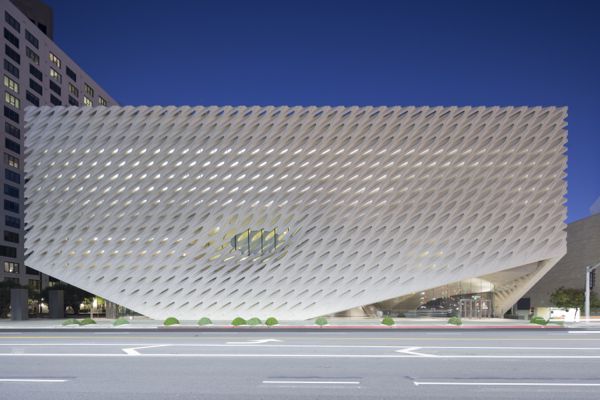
“There was a time when it was said that if you wanted to make it as an artist, you had to make it in New York,” said Eli Broad. “That’s no longer the case.”
The billionaire philanthropist was speaking at the Broad, the new private museum in Downtown Los Angeles that he commissioned with his wife Edythe to showcase their over 2,000-work collection. Over 85,000 tickets have reportedly already been reserved to view the acclaimed collection, which houses works by artists including Ed Ruscha, John Baldessari, Barbara Kruger, and Jeff Koons.
When the doors of the museum, a $140-million structure designed by Diller Scofidio and Renfro in collaboration with Gensler, open to the public on Sunday September 20 (admission is, and always will be, free), it will not only be a historical moment for the Los Angeles art scene, it will be a game changer.
Sherrie Levine, Fountain (after Marcel Duchamp: A.P.) (1991).
Image: Courtesy of the Broad.
So how much of the storied collection is on display? “About 15 percent; if you don’t include what’s displayed from our storage windows,” said Joanne Heyler, the museum’s director and chief curator. “Over time, there will be many in-depth displays of many of the artists that are part of the collection that are not on display today.”
“My colleagues [in the art world] say to me, ‘I can’t stay away from LA very long, without missing something essential,'” Ms. Heyler said talking further about the definitive shift from other cities, like New York, to Los Angeles. “To me, that’s the real key.”
Robert Therrien, Under the Table (1994).
Image: Courtesy of the Broad.
The new museum is awe-inspiring and breathtaking. Rooms are dedicated to various artists, such as Jeff Koons, Andy Warhol, Takashi Murakami, and Damien Hirst. The ground floor entrance area is deliberately sparse with only a couple of pieces on display. But this minimalist approach allows the viewer to immerse herself in the architecture. Whether you’re a modernist or not, it is undoubtedly beautiful and deserves your full attention.
Basquiat, Untitled.
Image: Courtesy of the Broad.
Why is the Broad one of the best museums in North America? Consider the following:
The Collection
“Los Angeles has become one of four major cultural capitals in the world, together with NY, London and Paris,” said Broad, “and I think Los Angeles has really become the contemporary art capital of the world.” With that in mind, when you walk through the museum and see Lari Pittman, Warhol, Kruger, and Koons, it becomes very difficult not to bend to Broad’s definitive statement.
The Storage Vault
Past the elevator, over a stainless steel railing and through a steep stairwell, a patch of glass offers a peek into the museum’s storage area known as “the vault,” which offers 21,000 square feet of collection storage space. Slat upon slat of art storage panels line up in meticulous, methodical perfection. It is almost a separate art installation in itself giving the viewer an intimate behind the scenes look at the heart of the museum.
Jeff Koons, Michael Jackson and Bubbles (1988).
Image: Courtesy of the Broad.
The Curation
Heyler has been with the Broads for over twenty years. She is the yin to their artistic yang. Her curation of the art on display (and heaven knows she’s familiar with every piece in the vault) is personal and intrinsically flattering—in a completely professional way—in the sense that she knows the art intimately; she can determine what piece will or will not complement the next.
The Architecture
It may have cost $140 million and many years, but it’s worth it. Working hand in hand with the Broads, Diller Scofidio + Renfro have created a space that is akin in scope to something like the Guggenheim, but more user-friendly, challenging, and approachable—from the ground up. On the Los Angeles front, the Getty may be approachable and LACMA offers many an interactive opportunity (see Chris Burden), but the Broad offers a level of intimacy, despite its large scale, like no other museum in LA County.
Yayoi Kusama, Infinity Mirrored Room—The Souls of Millions of Light Years Away.
Image: Courtesy of The Broad.
The Vibe
The Broads have been collectors for over 50 years. Like fellow influential collector couple Dorothy and the late Herb Vogel, their devotion and love for the art that graces these walls overflows into the very heart of the museum itself. The staff adore the couple, and have come to love the art as well. Many staffers gushed over their favorite pieces, only to switch gears halfway through their description. This lyrical love of art is apparent everywhere, from the first floor to the third, making the experience all the more enhanced by the loyalty and commitment of the entire team.
The App
Keeping up with the Millennials, et al, the Broad offers not one but four audio tours, including one that enlists artists Barbara Kruger and John Baldessari, among others, to weigh in on the art of their peers. There’s also an audio tour just for children, led by longtime art and education advocate, LeVar Burton.
“It took me a little by surprise,” said Ms. Heyler who discussed her favorite pieces with us, albeit slightly, “not because the artworks aren’t spectacular, which they are. But there is a wall on the third floor that has three 60s Lichtenstein paintings; there’s a Mondrian-referencing painting on the left, a black-and-white flower based in the center, and one of his classic comic strip blondes on the right. I think formally. . . it looks beautiful.”
Planning ahead, you can get 30–45 seconds in the Yayoi Kusuma installation, tripping the light fantastic. Do yourself a favor—don’t take your phone. By the time you attempt to get the perfect selfie, time will be up and you’ll have done yourself a terrible disservice. On the flip side, since the Broad is eternally free to everyone, there’s always another chance for a photo opp.